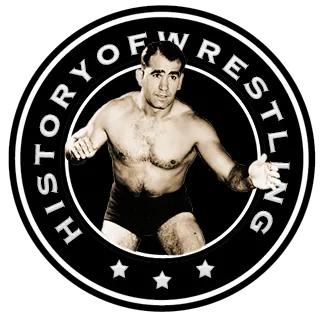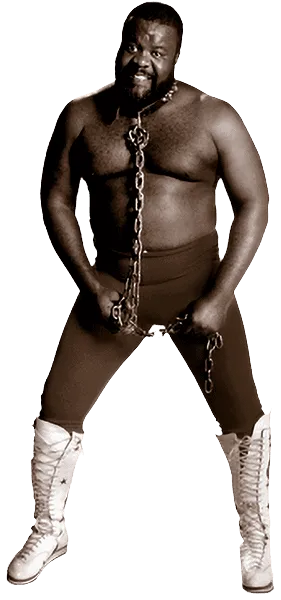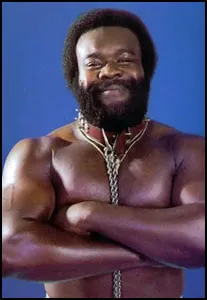by Stephen Von Slagle
During the decade of the 1980s, Sylvester Ritter (better known to the world as The Junkyard Dog) thrilled fans like few of his contemporaries. From New Orleans’ Superdome to Atlanta’s Omni to New York’s Madison Square Garden, the 280 lb. former professional football player-turned-wrestler was easily one of the most beloved superstars in the entire sport, as well as one of its biggest draws. At the height of the World Wrestling Federation’s popularity in the mid-1980s, JYD was one of the wrestlers that became a true mainstream celebrity and was known all across the country. However, JYD was a huge superstar long before he stepped foot inside a WWF ring and his exploits (as well as his drawing power) in Bill Watts’ Mid South promotion, as well as the NWA’s World Class and Georgia territories are legendary. In his day, The Junkyard Dog was truly a wrestling superstar like few others.
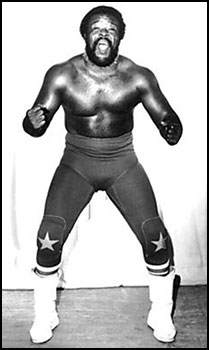 After a stint in pro football, Ritter wrestled a handful of dates in Tennessee before travelling north, competing as “Big Daddy” Ritter during the mid-1970s in Stu Hart’s Calgary-based Stampede Wrestling promotion. The athletic big man quickly made the transition from pro football to pro wrestling, and on December 1, 1978 he won the areas top belt, the Stampede North American Heavyweight championship. Wrestling as a heel, “Big Daddy” held the North American title for nearly six months before he was upset by another future superstar who was also breaking into the business through Stampede Wrestling, Jake Roberts. But after a four month reign by the future “Snake,” Ritter regained the title from Roberts, only to be defeated by Larry Lane after just a few weeks. Having learned much about his new craft while wrestling in Canada, Ritter moved on to new challenges — and unimagined fame — in America.
After a stint in pro football, Ritter wrestled a handful of dates in Tennessee before travelling north, competing as “Big Daddy” Ritter during the mid-1970s in Stu Hart’s Calgary-based Stampede Wrestling promotion. The athletic big man quickly made the transition from pro football to pro wrestling, and on December 1, 1978 he won the areas top belt, the Stampede North American Heavyweight championship. Wrestling as a heel, “Big Daddy” held the North American title for nearly six months before he was upset by another future superstar who was also breaking into the business through Stampede Wrestling, Jake Roberts. But after a four month reign by the future “Snake,” Ritter regained the title from Roberts, only to be defeated by Larry Lane after just a few weeks. Having learned much about his new craft while wrestling in Canada, Ritter moved on to new challenges — and unimagined fame — in America.
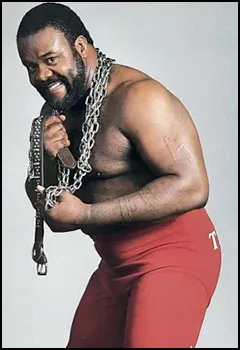 As The Junkyard Dog, Ritter, now a babyface, became one of the biggest stars the wrestling hotbed of the southern United States had ever seen. Once he traveled south, changing his name and persona, The Junkyard Dog quickly established himself as Mid-South wrestling’s top draw and most popular fan favorite. One of the first men of the 1980s to use ring music, whenever fans heard the opening bass notes of Queen’s “Another One Bites The Dust,” they knew the Dog was in the house and exploded with cheers. On March 14, 1980 in Shreveport, Louisiana, JYD won the Louisiana Heavyweight title by defeating one of his great enemies, “The Big Cat” Ernie Ladd. Not long after emerging victorious in his program with Ladd, JYD began the longest, most intense (and profitable) feud of his career.
As The Junkyard Dog, Ritter, now a babyface, became one of the biggest stars the wrestling hotbed of the southern United States had ever seen. Once he traveled south, changing his name and persona, The Junkyard Dog quickly established himself as Mid-South wrestling’s top draw and most popular fan favorite. One of the first men of the 1980s to use ring music, whenever fans heard the opening bass notes of Queen’s “Another One Bites The Dust,” they knew the Dog was in the house and exploded with cheers. On March 14, 1980 in Shreveport, Louisiana, JYD won the Louisiana Heavyweight title by defeating one of his great enemies, “The Big Cat” Ernie Ladd. Not long after emerging victorious in his program with Ladd, JYD began the longest, most intense (and profitable) feud of his career.
On May 2, 1980, a young Terry “Bam Bam” Gordy defeated The Junkyard Dog for his Louisiana Heavyweight title and at the same time began a legendary feud with The Freebirds that lasted for years. However, JYD regained his Louisiana title from Gordy just a few weeks later, adding it to the Mississippi Heavyweight championship he won from Bull Ramos the month prior. But, eventually the simultaneous Mississippi & Louisiana Heavyweight champion was forced to relinquish both of his hard-earned belts after a dramatic “sneak attack” by the young team of Gordy & Hayes, an attack that left The Junkyard Dog “blind” for several long months. After losing his sight due to the Freebirds’ hair removal cream, JYD eventually returned to gain his revenge during an inspirational Dog Collar match against Michael Hayes at the Superdome in front of over 28,000 fans, the biggest crowd ever to witness a Mid-South event. Following his “blinding,” area fans rallied behind JYD like never before and his appearances throughout the territory drew consistently large crowds for the Mid-South group, ushering in the most profitable era in the promotion’s history.
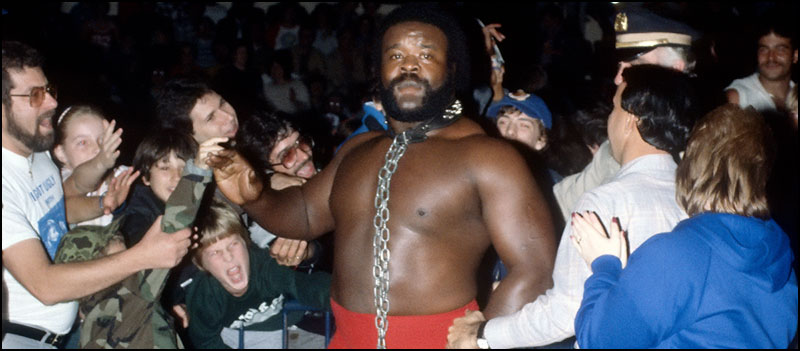 JYD also traveled to the NWA’s other successful regional promotions, such as Dallas’ World Class Wrestling, Georgia Championship Wrestling, and Paul Boesch’s Houston promotion, becoming a top performer and beloved hero everywhere he went. Far from being a “ring technician,” JYD had a very limited repertoire in terms of technical moves, to say the least. However, the moves the Dog did possess were more than enough to overwhelm most opponents. His head-butt, football tackle, and of course, his running powerslam (called the “Thump”) led to victory after victory for JYD.
JYD also traveled to the NWA’s other successful regional promotions, such as Dallas’ World Class Wrestling, Georgia Championship Wrestling, and Paul Boesch’s Houston promotion, becoming a top performer and beloved hero everywhere he went. Far from being a “ring technician,” JYD had a very limited repertoire in terms of technical moves, to say the least. However, the moves the Dog did possess were more than enough to overwhelm most opponents. His head-butt, football tackle, and of course, his running powerslam (called the “Thump”) led to victory after victory for JYD.
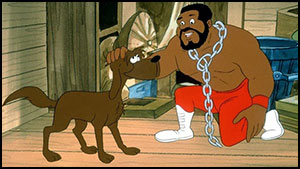 After several years of being one of the South’s most popular and successful wrestlers, Vince McMahon’s WWF, in the middle of its nationwide expansion, convinced Ritter to leave Mid-South and enter the World Wrestling Federation in 1984. From that point on, Ritter’s life (as well as that of Mid-South wrestling) was never the same. As part of the World Wrestling Federation, JYD became a national household name and, although he never wore any WWF gold, he was a huge star in the promotion for several of its best years. JYD’s merchandise was always a top seller and he appeared as a “special guest star” on numerous television shows. JYD, with his charismatic personality and good-natured charm, was a big hit with the WWF’s large fanbase of children and his animated character on the WWF’s Saturday morning CBS cartoon show, Hulk Hogan’s Rock `N Wrestling, was very popular. In the ring, the Dog continued his winning ways in feuds with numerous opponents, including his old Stampede rival Jake “The Snake” Roberts, the effeminate Adrian Adonis, and of course, “King” Harley Race. JYD’s feud with Race over the King of the Ring crown and robe was perhaps his last major feud in the WWF, as he slowly began to slide down the ladder after several years of competing in the Federation.
After several years of being one of the South’s most popular and successful wrestlers, Vince McMahon’s WWF, in the middle of its nationwide expansion, convinced Ritter to leave Mid-South and enter the World Wrestling Federation in 1984. From that point on, Ritter’s life (as well as that of Mid-South wrestling) was never the same. As part of the World Wrestling Federation, JYD became a national household name and, although he never wore any WWF gold, he was a huge star in the promotion for several of its best years. JYD’s merchandise was always a top seller and he appeared as a “special guest star” on numerous television shows. JYD, with his charismatic personality and good-natured charm, was a big hit with the WWF’s large fanbase of children and his animated character on the WWF’s Saturday morning CBS cartoon show, Hulk Hogan’s Rock `N Wrestling, was very popular. In the ring, the Dog continued his winning ways in feuds with numerous opponents, including his old Stampede rival Jake “The Snake” Roberts, the effeminate Adrian Adonis, and of course, “King” Harley Race. JYD’s feud with Race over the King of the Ring crown and robe was perhaps his last major feud in the WWF, as he slowly began to slide down the ladder after several years of competing in the Federation.
By the end of the decade, The JunkYard Dog moved on to new challenges, specifically a run in the NWA against World Champion Ric Flair. As part of Sting’s “Dudes with Attitudes” counter-Horsemen group, he created numerous headaches for Flair & Co., and competed on several NWA Clash of the Champions cards and PPV’s before disappearing after the angle had run its course. However, after some time away, he returned to the promotion (by then renamed WCW) and again challenged Flair. During this second stint in WCW, JYD also patched up his longtime feud with “Freebird” Michael Hayes and the two formed a fairly successful tag team together. But, after a year or so in WCW, JYD again faded out of the promotion’s storylines. Although he was still very popular, it was clear that, after 15 years in the game, and a considerable amount of weight gain, he was no longer the steamrolling wrestler he’d once been.
However, Ritter proved on the independent circuit that he could still draw a crowd and entertain his fans. JYD competed in various indie promotions throughout the 1990s, including the short-lived NWA Dallas group as well as the NWC in Las Vegas.
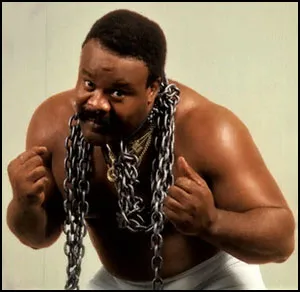 In 1998, JYD made a surprise, and well-received, appearance at ECW’s Wrestlepalooza event. Several years later, on March 13, 2004, The Junkyard Dog was inducted into the WWE Hall of Fame by his old nemesis (and former booker) “The Big Cat” Ernie Ladd.
In 1998, JYD made a surprise, and well-received, appearance at ECW’s Wrestlepalooza event. Several years later, on March 13, 2004, The Junkyard Dog was inducted into the WWE Hall of Fame by his old nemesis (and former booker) “The Big Cat” Ernie Ladd.
On June 2, 1998, Sylvester Ritter, The Junkyard Dog, fell asleep at the wheel and was killed in an auto accident at the age of 45.
